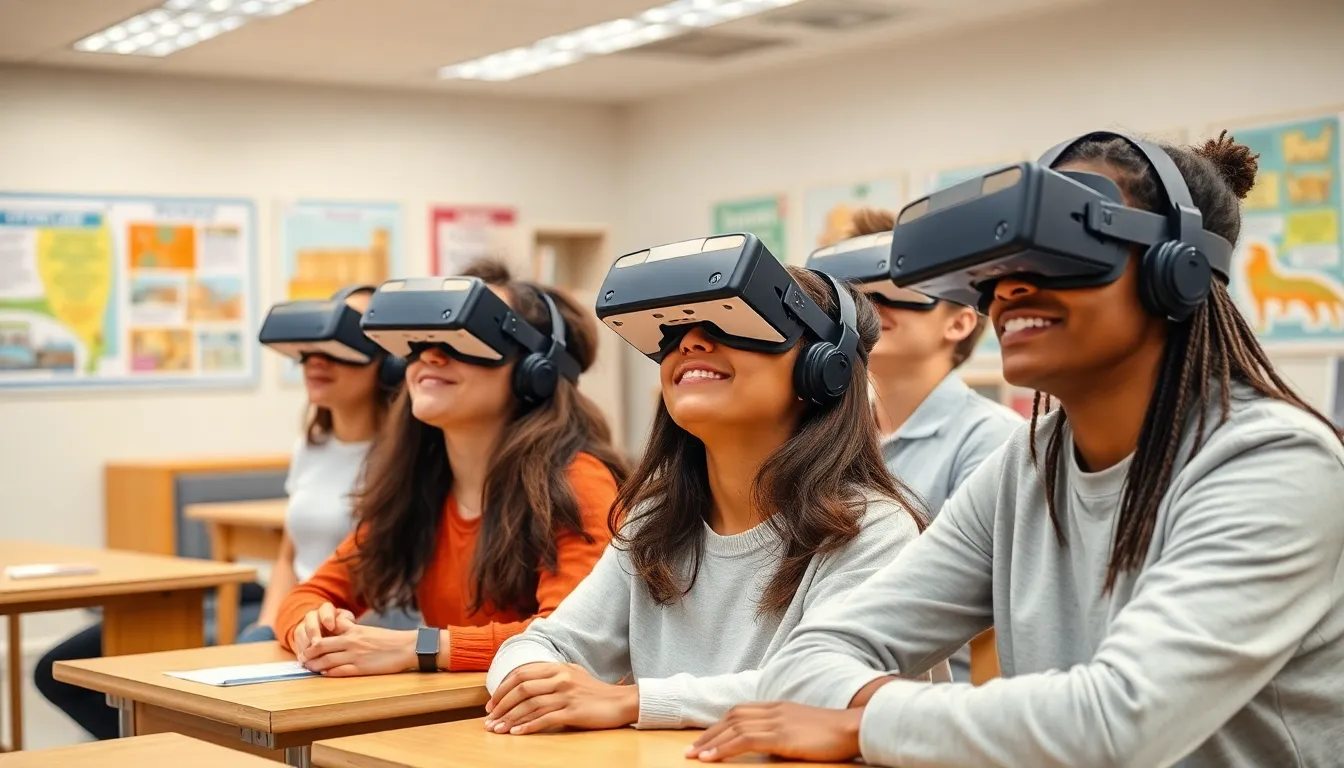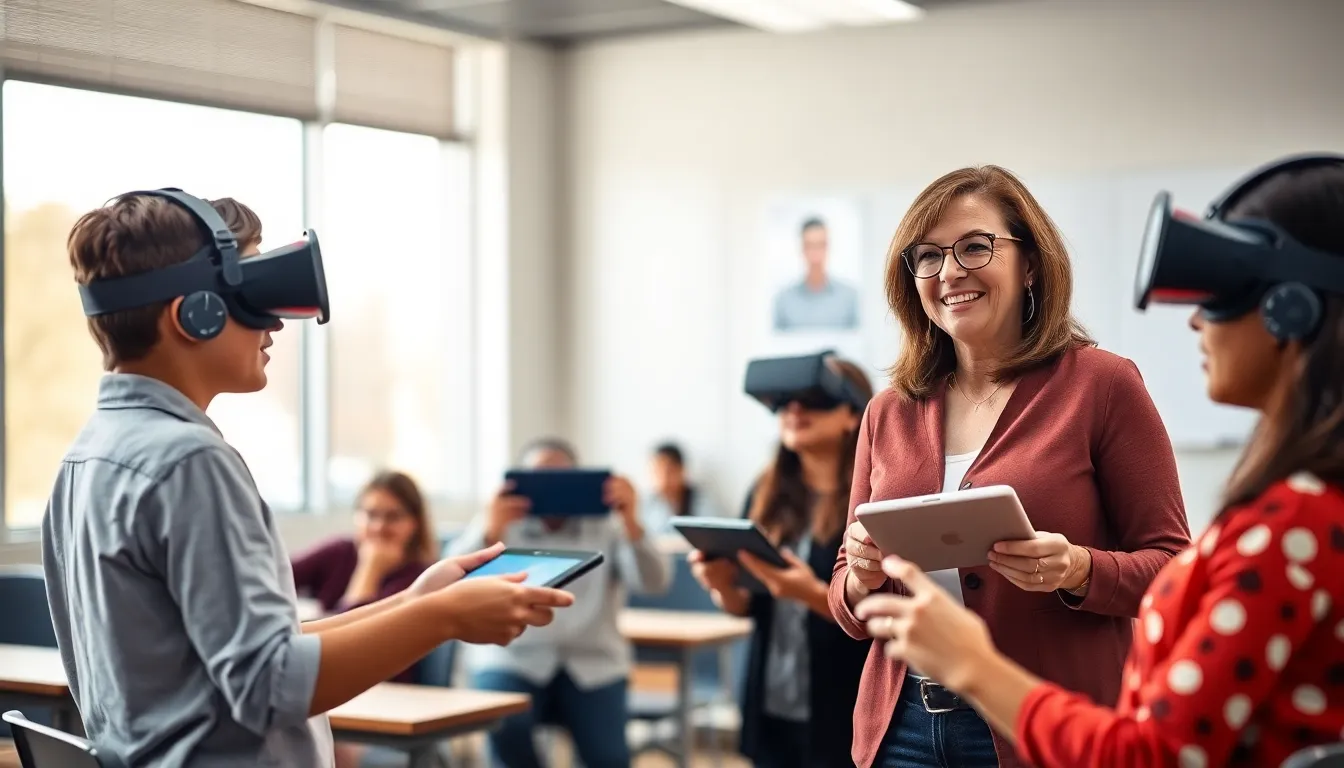Table of Contents
ToggleIn a world where textbooks are slowly being outpaced by smartphones, emerging technologies in education are shaking things up in the best way possible. Imagine a classroom where virtual reality transports students to ancient civilizations or where artificial intelligence personalizes learning experiences like a tailored suit. That’s not science fiction—it’s happening right now!
Overview of Emerging Technologies in Education
Emerging technologies revolutionize the education sector by enhancing engagement and accessibility. Virtual reality (VR) enables immersive experiences, allowing students to visit historical landmarks or explore complex scientific concepts from their classrooms. Augmented reality (AR) layers digital information over physical environments, providing interactive learning opportunities through devices like smartphones and tablets.
Artificial intelligence (AI) personalizes education by analyzing individual learning styles and performance. It helps create customized lesson plans and offers immediate feedback, which boosts student motivation and retention. Learning management systems (LMS) streamline course delivery, enabling institutions to organize resources and track student progress efficiently.
Adaptive learning technologies adjust educational content in real-time based on learner performance. These systems help identify areas where students struggle, fostering a tailored approach that meets diverse needs. Gamification also plays a role in modern classrooms by integrating game elements into learning activities, making the educational process more enjoyable and engaging.
Cloud computing simplifies collaboration among students and educators. With access to resources anywhere, learners can participate in group projects or discussions without geographical barriers. Additionally, 3D printing creates hands-on learning experiences, allowing students to design and fabricate prototypes in subjects like engineering and art.
Data analytics provides insights into student behavior and outcomes. By examining this information, educators can refine teaching methods and improve curriculum effectiveness. Blockchain technology ensures secure and transparent records for academic achievements, enhancing credential verification and combating fraud.
Each of these technologies offers unique benefits, collectively shaping the future of education. They bridge gaps and create opportunities for learners, embracing innovation in teaching and learning environments.
Benefits of Emerging Technologies

Emerging technologies significantly enhance educational outcomes. These advancements facilitate richer experiences for learners.
Enhanced Learning Experiences
Modern classrooms utilize virtual reality to immerse students in vivid environments. Students engage with ancient civilizations, exploring historical contexts firsthand. Personalized learning becomes attainable through artificial intelligence, which adapts content to match individual needs. Gamification keeps learners motivated by integrating game-like challenges into lessons. Interactive platforms enable collaboration, fostering teamwork and problem-solving skills. These methods not only improve retention but also stimulate curiosity, driving deeper understanding of subjects.
Increased Accessibility
Emerging technologies break down traditional barriers in education. Augmented reality offers interactive content without geographic constraints, making learning available to diverse populations. Cloud computing allows students to access resources anytime, enhancing flexibility. For learners with disabilities, adaptive tools provide tailored assistance, ensuring inclusivity. Online learning management systems streamline course delivery for both educators and students. Data analytics helps track performance, allowing for prompt interventions. Collectively, these technologies promote an equitable learning environment, making education accessible for everyone.
Challenges in Implementation
Implementing emerging technologies in education presents several challenges that institutions must address for effective adoption.
Infrastructure Limitations
Many schools encounter significant infrastructure limitations when integrating new technologies. Insufficient internet connectivity affects students’ ability to access digital resources. Outdated hardware can hinder the use of advanced tools, preventing educators from maximizing their potential. Additionally, budget constraints often restrict investments in necessary upgrades and maintenance. Schools in rural areas face particularly acute challenges, where reliable access to high-speed internet remains scarce. A lack of suitable physical spaces for immersive technologies like VR can also restrict implementation. Addressing these infrastructure issues is crucial for successful integration of technological advancements.
Teacher Training and Support
Proper training and ongoing support for teachers are essential components of technology integration. Many educators feel unprepared to utilize emerging tools effectively due to limited professional development opportunities. Training programs often overlook instructional strategies specific to new technologies. With rapid advancements, ongoing support becomes vital to help teachers adapt and grow their skills. Institutions that invest in comprehensive training opportunities can foster greater confidence and competency among staff. Engaging teachers in the selection and implementation process can also enhance their buy-in and motivation to use new tools effectively.
Key Emerging Technologies
Emerging technologies are transforming education through innovative solutions that enhance learning experiences. Key advancements include artificial intelligence, virtual and augmented reality, and blockchain technology.
Artificial Intelligence and Machine Learning
Artificial intelligence personalizes learning experiences. Educators use AI algorithms to analyze students’ learning patterns, adapting content based on individual needs. Machine learning enhances these systems by continually improving the educational process as more data becomes available. Adaptive assessments provide real-time feedback, allowing students to progress at their own pace. AI chatbots assist in answering queries, offering support outside traditional classroom hours.
Virtual and Augmented Reality
Virtual reality engages students in immersive environments that bring subjects to life. Students can explore historical sites or conduct science experiments in simulated settings, enhancing understanding and retention. Augmented reality supplements traditional materials by overlaying digital content onto physical objects, creating interactive learning experiences. Users access virtual field trips or instructional aids through devices like smartphones and tablets. This technology fosters collaboration and creativity, making lessons more impactful.
Blockchain in Education
Blockchain technology improves the security of academic records. It offers a decentralized system that prevents unauthorized access and manipulation of credentials. Institutions utilize blockchain to create tamper-proof records of certifications and achievements. Transparency within the system enhances trust among stakeholders. Learners can control their data, sharing it securely with prospective employers or educational institutions, fostering a decentralized approach to academic validation.
Future Trends in Education Technology
Artificial intelligence stands at the forefront of future education technology, shaping personalized learning experiences. Algorithms analyze student progress and adapt lesson plans accordingly, enhancing engagement. Virtual reality continues to evolve, offering immersive simulations that transport students into new worlds and historical events.
Augmented reality strengthens traditional learning materials by overlaying interactive digital content atop textbooks. Real-time collaboration tools enable students to work together on projects from various locations, fostering creative problem-solving. Learning management systems evolve, streamlining course delivery and improving user experience for both educators and students.
Gamification is gaining traction, incorporating game elements to motivate students, making learning more enjoyable. Cloud computing further democratizes access to resources, allowing students from diverse backgrounds to connect with educational content anytime, anywhere. Enhanced 3D printing technology provides hands-on learning experiences, bridging the gap between theory and practical application.
Data analytics plays a crucial role in tracking student performance and providing insights into learning behaviors. Educators utilize this information to refine teaching methodologies, ensuring effective interventions when necessary. Blockchain technology is becoming essential, securing academic records and enhancing transparency.
Emerging trends call for robust teacher training initiatives, ensuring educators adapt to new technologies competently. Schools prioritize investing in infrastructure to address connectivity and equipment challenges. Proactive planning and support lead to successful integration, maximizing the impact of these innovations on educational outcomes.
The integration of emerging technologies in education is not just a trend; it’s a pivotal shift that’s reshaping how learning occurs. As tools like AI VR and AR become more prevalent they’re creating dynamic and personalized learning environments that cater to diverse student needs.
While challenges remain such as infrastructure limitations and the need for effective teacher training the potential benefits are immense. By investing in these technologies and addressing existing barriers educators can foster a more inclusive and engaging educational landscape.
Ultimately the future of education lies in the successful adoption of these innovations ensuring that every learner has access to rich and meaningful experiences.




